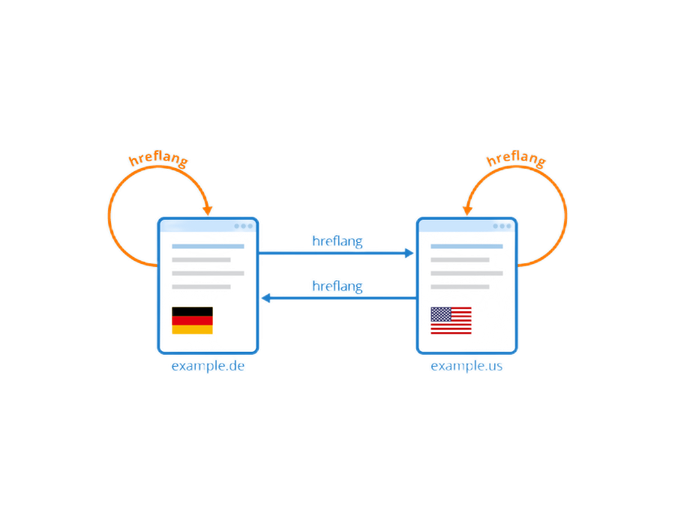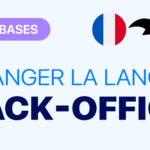Optimize your international SEO on PrestaShop
Optimizing international SEO is essential for any PrestaShop e-merchant targeting a global clientele.
This article will provide you with practical advice and concrete tips to improve your international search engine optimization.
We will cover the technical, linguistic and cultural aspects of global SEO.
Whether you’re starting out or looking to refine your strategy, you’ll find PrestaShop-adapted solutions here to increase your visibility in foreign markets.

Anatole
E-commerce translation expert
International SEO basics
Conquering new foreign markets with your PrestaShop store cannot be improvised. International SEO requires a methodical approach that goes well beyond simply translating your existing pages.Differences between local and international SEO
Local SEO focuses on a single territory with its homogeneous linguistic and cultural specificities. Conversely, international SEO must juggle multiple realities:- Different languages, sometimes with significant regional nuances
- Search engines that vary by country (Google dominates in Europe, but gives way to Baidu in China or Yandex in Russia)
- Search behaviors specific to each culture
- A legal framework that changes from one country to another (GDPR in Europe, CCPA in California…)
 The explanation? Italians were searching for completely different terms for the same products.
The explanation? Italians were searching for completely different terms for the same products.
Keyword research by territory
Keyword research takes on a new dimension when working internationally:- Each market has its own search ecosystem
- Search intentions can vary considerably
- Seasonality differs according to hemisphere and local habits
- Use tools like SEMrush or Ahrefs by filtering by country
- Check Google suggestions specific to each language
- Analyze your local competitors rather than your usual competitors
- Don’t hesitate to ask for help from native speakers who know common expressions
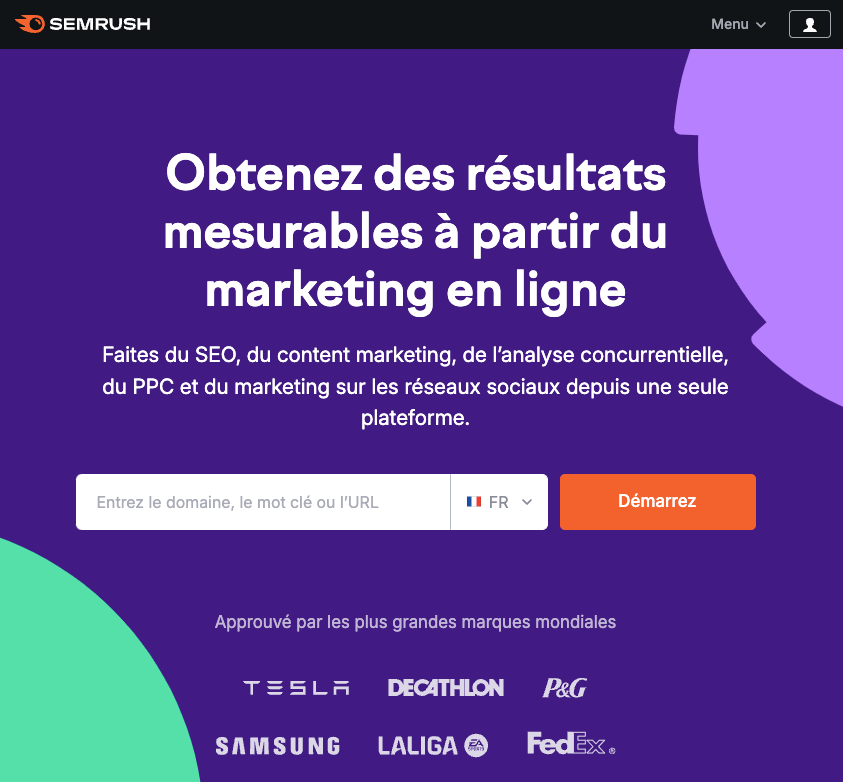

Technical configuration of PrestaShop
Multilingual settings
PrestaShop natively offers powerful multilingual management:- Go to “International > Localization > Languages” to activate the desired languages
- Configure the corresponding currencies in “International > Localization > Currencies”
- Define your geographical zones and associated taxes
- Don’t forget to adapt your shipping methods by country
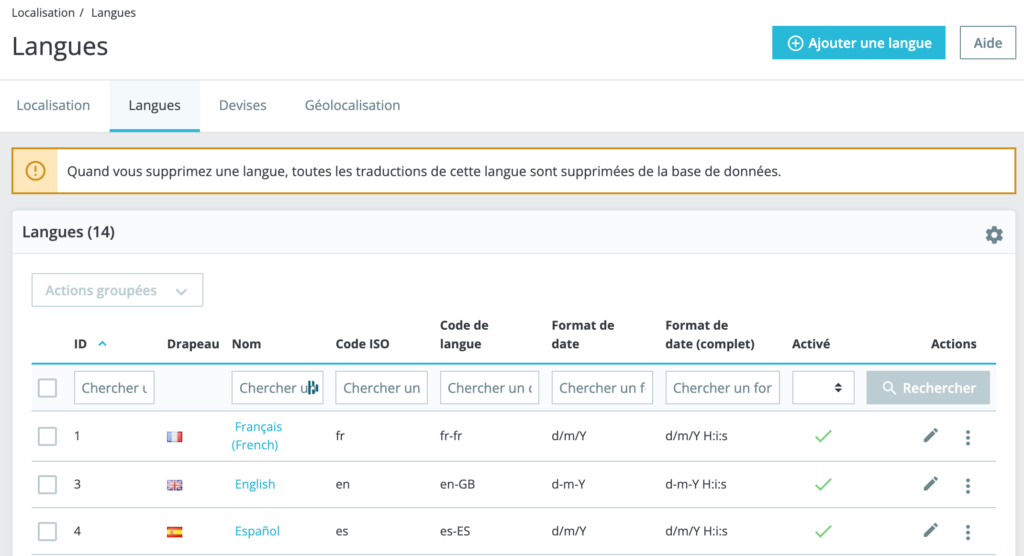
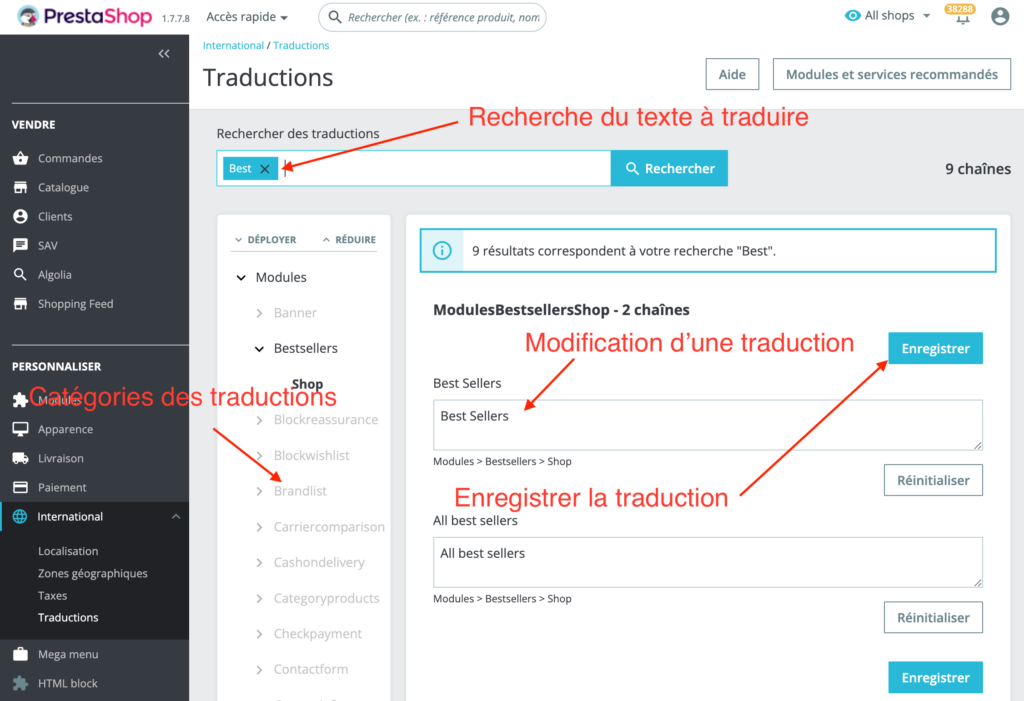
URL structure for international
Three options are available for structuring your international URLs:- By subdomain: fr.boutique.com, es.boutique.com
- By directory: boutique.com/fr/, boutique.com/es/
- By domain: boutique.fr, boutique.es
- Access “Shop Parameters > Traffic & SEO”
- Customize the URL format for each language
- Enable URL rewriting to optimize structure
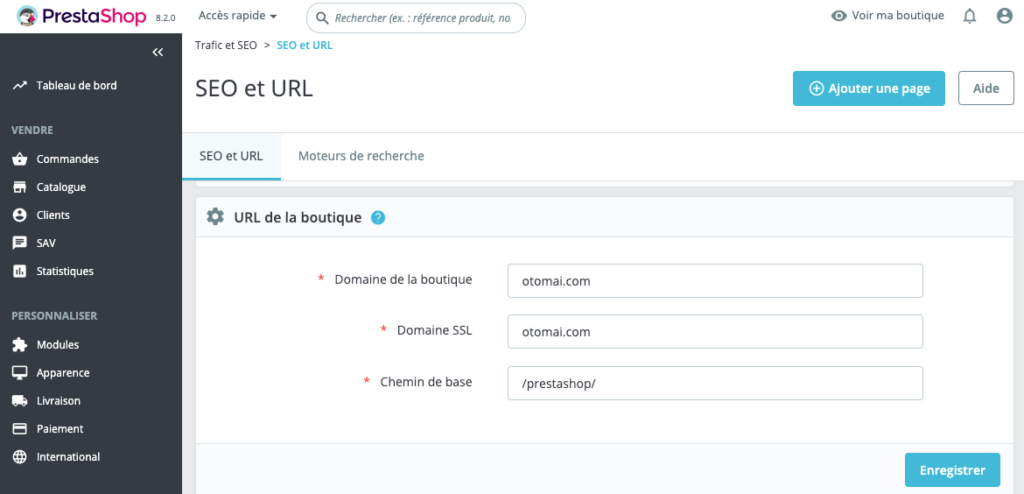
Hreflang tags implementation
These tags are essential for indicating to Google the relationship between your different language versions:<link rel="alternate" hreflang="fr" href="https://boutique.com/fr/" />
<link rel="alternate" hreflang="es" href="https://boutique.com/es/" />
<link rel="alternate" hreflang="x-default" href="https://boutique.com/" />International loading speed
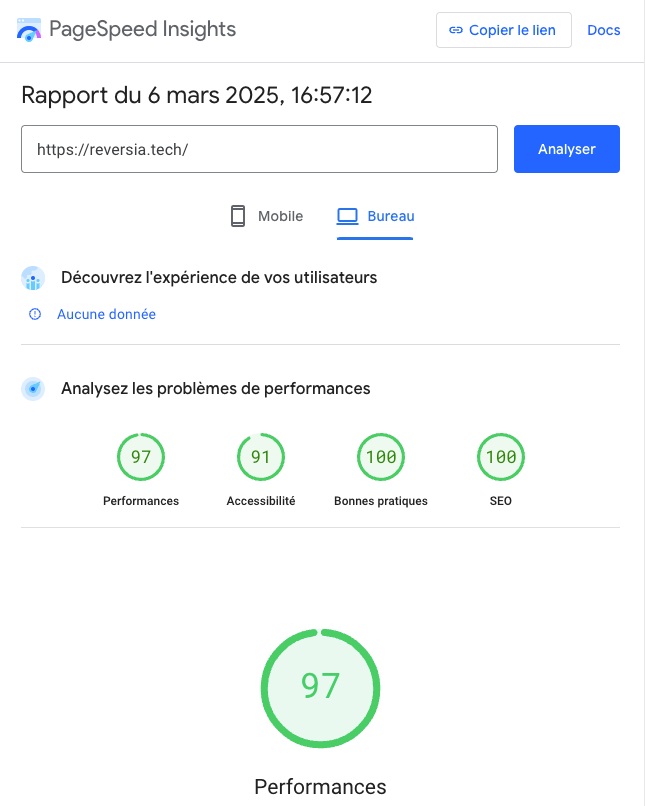
- Opt for a CDN with points of presence in your target markets
- Adapt image weight according to average connection speeds by country
- Prioritize loading of elements visible above the fold
- Regularly measure performance with local IPs for a realistic view
Google Search Console configuration
To effectively track your international performance:- Add all your language versions as separate properties
- Specify geographical targeting when relevant
- Create separate sitemaps for each language
- Monitor crawl errors specific to each version
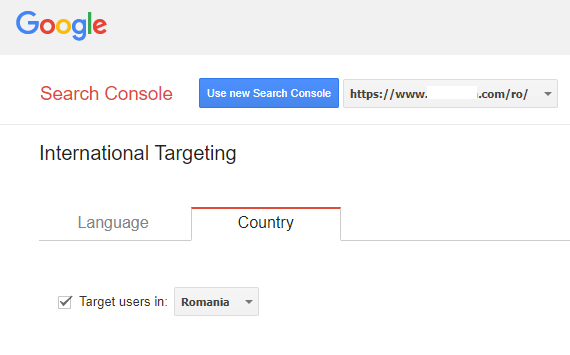 With this solid technical foundation, you can then focus on adapting your content to the cultural specificities of each market.
With this solid technical foundation, you can then focus on adapting your content to the cultural specificities of each market. Methods to translate your PrestaShop?
To succeed in your international SEO strategy on PrestaShop, the choice and configuration of translation modules play a decisive role. Here’s an overview of available solutions and best practices for using them effectively.Third-party modules
For an international project, installing a module can be worthwhile:1. PrestaShop Translate Pro
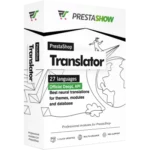 This official module offers:
This official module offers:
- Automatic translation via Google API or DeepL
- An intuitive user interface
- The ability to bulk translate products and categories
- A review system to correct automatic translations
2. G-Translate
 This alternative offers:
This alternative offers:
- Visual editing of translations directly on the front-office
- Automatic detection of content to translate
- Management of theme and module translation strings
- Proven compatibility with PrestaShop 1.7 and 8.0
3. Glotio Module
 Adapted for small catalogs:
Adapted for small catalogs:
- Collaborative translation with rights management by language
- Translation memory to maintain consistency
- Integrated validation workflow
- Connectors with professional translation platforms
Reversia: The translation solution dedicated to PrestaShop
 Among the translation modules available on the market, Reversia stands out as a solution specifically designed for PrestaShop stores looking to develop internationally.
Among the translation modules available on the market, Reversia stands out as a solution specifically designed for PrestaShop stores looking to develop internationally.
Key features of Reversia
 Reversia directly addresses the needs of e-merchants using PrestaShop with several major advantages:
🤖 Integrated automatic translation
Reversia connects to the most efficient translation engines on the market to translate your entire store without requiring particular technical skills
📝 Custom glossary management
You can create and maintain a multilingual glossary including your specific terms, brand names and industry expressions to ensure translation consistency
🔍 Native SEO optimization
The module automatically manages metadata and hreflang tag implementation, essential for multilingual SEO
✌️ Frictionless integration
Designed specifically for PrestaShop, Reversia integrates perfectly with the administration interface without complex code modifications
Reversia directly addresses the needs of e-merchants using PrestaShop with several major advantages:
🤖 Integrated automatic translation
Reversia connects to the most efficient translation engines on the market to translate your entire store without requiring particular technical skills
📝 Custom glossary management
You can create and maintain a multilingual glossary including your specific terms, brand names and industry expressions to ensure translation consistency
🔍 Native SEO optimization
The module automatically manages metadata and hreflang tag implementation, essential for multilingual SEO
✌️ Frictionless integration
Designed specifically for PrestaShop, Reversia integrates perfectly with the administration interface without complex code modifications
Advantages for international SEO
Using Reversia presents several concrete benefits for your international SEO strategy:- Terminological consistency across all languages thanks to the glossary system
- Technical structure optimized for multilingual content recognition by search engines
- Complete translation including often neglected elements like image alt attributes or category descriptions
- Automated hreflang tag management, avoiding common implementation errors
SEO optimization of translations
Raw translation is not enough for SEO. A few golden rules:Keyword adaptation
Translation modules must be complemented by specific SEO optimization work:- Configure specific glossaries with your priority keywords
- Avoid automatic translation of title tags and meta descriptions
- Adapt translated URLs to local search practices
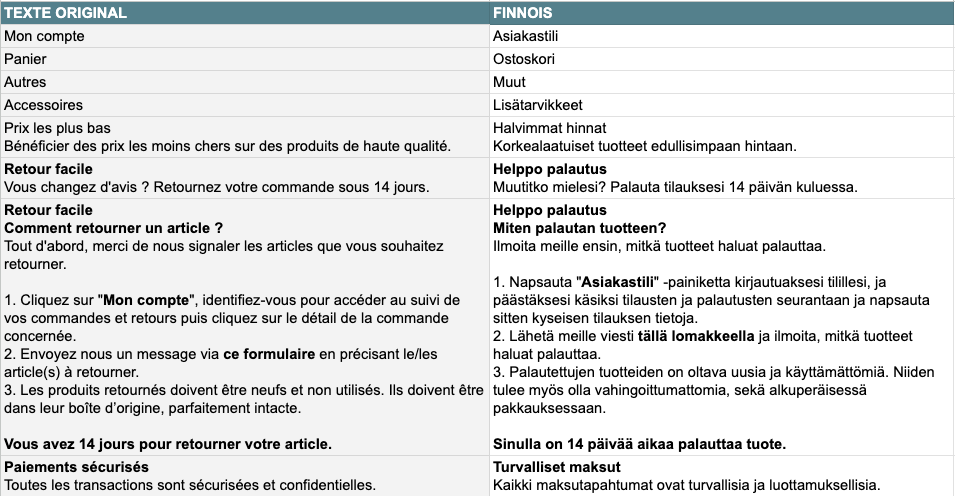
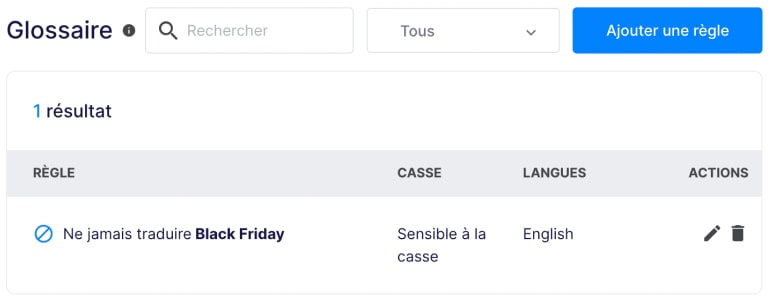
Managing cultural variations
Even for the same language, regional variations can be crucial:- Differentiate Spanish from Spain and Latin America
- Adapt French for France, Belgium, Switzerland and Canada
- Consider the specificities of British vs American English
Translation maintenance and updates
Translation work is never finished:- Plan an update process when adding new products
- Monitor missing translations
- Set up an alert system for untranslated content
- Regularly review automatic translations of strategic content
Content optimization
Once the technical foundations are laid and translation tools are in place, content optimization becomes the keystone of your international SEO strategy. Here’s how to adapt your content to seduce both search engines and users in each target country.Beyond simple translation
The difference between a store that performs internationally and one that fails often lies in the quality of cultural adaptation of its content:- Localization vs translation: Don’t just translate word for word. Good localization takes into account cultural references, local humor and idiomatic expressions
- Adaptation of sales arguments: Purchase motivations vary considerably from one country to another. Germans often prioritize technical quality, while Italians are more sensitive to design and aesthetics
- Reverse seasonality: Don’t forget that seasons are reversed in the southern hemisphere. Your summer collection cannot be highlighted in December in Australia
Product sheet optimization
Product sheets represent the heart of your e-commerce SEO strategy and deserve special attention:Structure optimized for each market
- Adapted titles: Integrate priority keywords from the local market. For example, “baskets” in France becomes “sneakers” in the UK and “tenis” in Spain
- Localized attributes: Adapt sizes (EU/UK/US), measurement units (cm/inches) and technical characteristics according to local standards
- Enriched descriptions: Develop more detailed content for markets where long product sheets perform better (like Germany)
Adapted multimedia elements
Visuals and media play a crucial role in optimization:- Adapt image file names with keywords in the target language
- Translate and optimize alt attributes for each market
- Consider localized videos for flagship products (subtitles are not always enough)
- Adapt product demonstrations to local uses
Creating relevant local content
Editorial content represents a major opportunity to improve your international SEO:Optimized multilingual blog
An active blog in each target language allows you to:- Target the long tail of keywords specific to each market
- Address local issues (regulations, trends, events)
- Create seasonal content adapted to the local calendar
- Develop partnerships with local influencers
Localized buying guides
Buying guides represent a major SEO opportunity, but require extensive adaptation:- Research specific questions that local buyers ask themselves
- Adapt your advice to local usage practices
- Integrate certifications and labels recognized in each country
- Mention relevant local regulations
Multilingual metadata management
The technical elements of your content require special attention:Targeted optimization of title tags
- Adapt title length to local search engine practices (Yandex has different preferences from Google)
- Place main keywords at the beginning of titles for Asian markets
- Include your brand differently depending on its local recognition
Adapted meta descriptions
- Create commercial hooks that resonate with local purchase motivations
- Adapt call-to-actions to cultural habits
- Respect character limits that may vary according to alphabets (Cyrillic, Asian)
Adapted linking strategy
Internal and external link structure must be rethought for each market:Optimized internal linking
- Create navigation paths adapted to local shopping habits
- Develop specific category pages responding to popular searches in each country
- Use optimized link anchors in the target language
Local backlink strategy
External links must come from the local ecosystem:- Identify authority sites in each target country
- Look for partnership opportunities with local players
- Adapt your press releases to local journalistic formats
- Participate in industry events in each country
Testing and continuous optimization
International content optimization is never finished:- Analyze performance by country and identify content that over/under-performs
- Test different localization approaches on segments of your catalog
- Collect customer feedback to identify cultural misunderstandings
- Follow the evolution of search trends in each market
Common mistakes and how to avoid them
Launching international SEO with PrestaShop has its share of pitfalls. Let’s look at the most common mistakes and, above all, how to avoid them to ensure the success of your strategy.
Technical configuration errors
1. Neglecting hreflang tags
The most widespread error concerns incorrect implementation of hreflang tags:
- Typical error: Forgetting to include all language versions on each page, including self-reference
- Consequence: Google doesn’t understand the relationships between your different language versions, leading to duplicate content problems
- Solution: Verify that each page of each language version contains the complete set of hreflang tags, including a reference to itself
I’ve seen a fashion site lose 40% of its organic traffic after an international redesign, simply because its hreflang tags pointed to incorrect URLs.
2. Inappropriate URL structure
Choosing the wrong URL structure can compromise your entire strategy:
- Typical error: Mixing different approaches (subdomains for some languages, subdirectories for others)
- Consequence: Confusion for search engines and difficulty establishing consistent domain authority
- Solution: Adopt a uniform approach for all your language versions
3. Automatic redirection based on IP
Forced redirection of users should be avoided:
- Typical error: Automatically redirecting visitors to the language version corresponding to their IP location
- Consequence: Prevents Google from properly crawling your different versions and frustrates users who want to access a specific version
- Solution: Offer language change suggestions, but always leave the final choice to the user
Duplicate content problems
1. Partial site translation
Incomplete translation is worse than no translation:
- Typical error: Translating only product sheets while neglecting institutional pages, footer, terms and conditions or blog
- Consequence: Degraded user experience and negative signal for search engines
- Solution: Use tools like “PrestaShop Translation Scanner” to identify untranslated content
2. Identical content across multiple language versions
Copy-pasting between language versions is disastrous:
- Typical error: Using the same English content for American, British, Canadian and Australian markets
- Consequence: Keyword cannibalization between your different versions
- Solution: Even for similar languages, adapt at least 30% of the content with local references, relevant examples and specific vocabulary
3. Automatic translation without revision
Blind trust in automatic translation can be costly:
- Typical error: Deploying automatic translations without any human revision
- Consequence: Mistranslations, incorrect terminology and loss of user confidence
- Solution: Reserve at minimum a human revision for strategic pages (homepage, main categories, top products)
Poor management of international redirections
1. Redirect chains
Cascading redirects slow down indexation and users:
- Typical error: Creating redirect chains when reorganizing international architecture
- Consequence: Loss of SEO juice and degraded user experience
- Solution: Ensure all redirects point directly to the final destination
2. 302 redirects instead of 301
Choosing the wrong type of redirect has consequences:
- Typical error: Using temporary redirects (302) for permanent changes to international structure
- Consequence: Incomplete transfer of SEO authority between URLs
- Solution: Systematically use 301 redirects for permanent changes
Geographic targeting errors
1. Incorrect configuration in Search Console
Neglecting Google settings can be costly:
- Typical error: Not correctly defining geographic targeting in Search Console
- Consequence: Poor ranking in local search results
- Solution: For generic domains (.com, .org), explicitly specify the target country in Search Console. For national domains (.fr, .de), targeting is automatic
2. Inconsistency of localization signals
Contradictory signals disrupt search engines:
- Typical error: Inconsistently mixing currencies, languages and shipping countries
- Consequence: Confusion for Google and users about the market actually being targeted
- Solution: Align all your localization signals (language, currency, address, phone number, shipping countries)
Neglect of cultural factors
1. Ignoring local navigation habits
Interfaces that work in one country may fail in another:
- Typical error: Applying the same purchasing journey to all markets
- Consequence: High bounce rate and low conversion on certain markets
- Solution: Analyze navigation behaviors by country and adapt the user experience accordingly
2. Ignorance of local regulations
Ignoring local laws can be risky:
- Typical error: Using the same legal notices and privacy policies for all countries
- Consequence: Legal risks and loss of user confidence
- Solution: Adapt your legal pages to each market’s regulations (GDPR in Europe, CCPA in California, etc.)
3. Standardized marketing calendar
A uniform calendar ignores local specificities:
- Typical error: Applying the same promotional calendar to all markets
- Consequence: Missed opportunities to capitalize on local peak times
- Solution: Establish a specific marketing calendar for each country, integrating local holidays and events
Tracking and analysis errors
1. Incorrect configuration of analysis tools
Poor analytical configuration makes optimization impossible:
- Typical error: Using a single Analytics view for all language versions
- Consequence: Inability to finely analyze performance by market
- Solution: Create distinct views per country/language in Google Analytics and properly configure cross-domain tracking if necessary
2. Absence of conversion tracking by language/country
Lack of granularity in tracking limits optimization:
- Typical error: Not segmenting goals and conversions by market
- Consequence: Inability to identify performing markets and optimize ROI
- Solution: Configure specific goals by country and regularly analyze commercial performance of each version
Avoiding these common mistakes doesn’t guarantee immediate success, but will allow you to avoid the pitfalls that have caused many international SEO strategies on PrestaShop to fail.
Technical vigilance, attention to cultural details and rigorous monitoring constitute the foundations of successful international expansion.
Translate and launch your store internationally with Reversia!Réessayer


